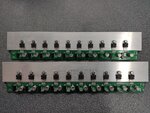Xenobius
Member level 5
I'd suggest a pragmatic approach. Remove C5 and check if the circuit is behaving according to your needs.
If you look at LM317 load transient response your 2 ms rate is the
dominant system characteristic. The 317 is more than capable of
handling that.
View attachment 163156
Regards, Dana.
Hi Dana,
This is very good news to me
Tonight I plan to desolder the diode and capacitor, replace all the transistors because those that did not blow up have a dark mark on their surface and will try again. I have a feeling the LM317 also got a beating. I'm not sure if I should just replace all 10x LM317 or not. I have some spare so I might as well get rid of the doubt.

